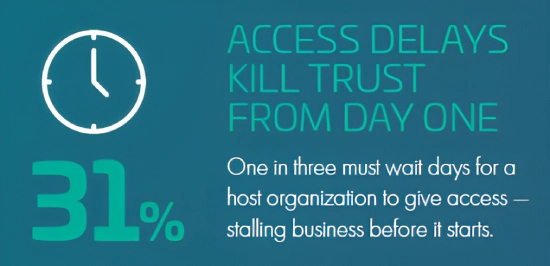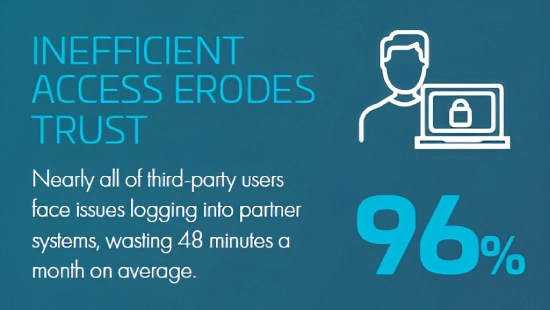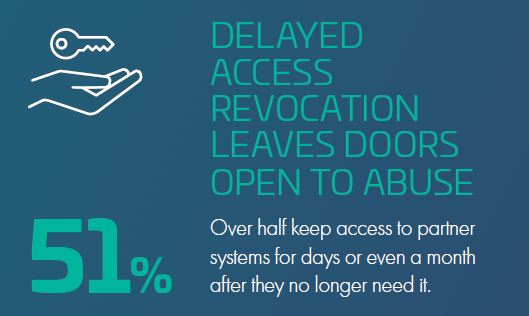 Haider Iqbal | Director of Product Marketing
More About This Author >
Haider Iqbal | Director of Product Marketing
More About This Author >
 Haider Iqbal | Director of Product Marketing
More About This Author >
Haider Iqbal | Director of Product Marketing
More About This Author >
Nearly every partner, vendor, or supplier you rely on still struggles with slow, clunky access. The Thales 2025 Digital Trust Index – Third-Party Edition shows that trust between businesses rarely disappears in a single, catastrophic breach — it fades through everyday friction that partners quietly resent until it affects collaboration.

One in three users wait days just to get initial access. Almost all face ongoing login issues, wasting time and slowing collaboration.
These are the small moments that quietly drain confidence—not dramatic breaches, but friction in everyday access.
When Authentication Holds Partners Back

Access and identity checks should build trust, but clunky authentication does the opposite. Nearly every third-party user — 96 percent — said they still run into login problems with host organizations’ systems. On average, each user wastes 48 minutes every month just trying to get into the systems they need — time that adds up quickly across entire partner teams.
Cumbersome logins, repeated credential prompts, downtime during authentication, forgotten passwords, and multi-factor steps that frustrate instead of protecting — these headaches pile up. And they matter. When asked, 86 percent said they could name at least one way their partners could make access smoother and more secure.
No partner will walk away overnight because of clunky logins. But when everything else is equal — especially in competitive markets — poor access adds just enough friction to slow down real work. Over time, even small gaps can get in the way at the worst moment — when a partner needs to deliver quickly and reliably. That’s often when trust is won or lost.
Onboarding and Offboarding Put Trust to the Test
Trust starts from the moment a third-party user is onboarded. If the initial experience is confusing, delayed, or poorly managed, it can create friction before any real work begins. According to the report, 85 percent of respondents said improving access provisioning and modification would make the biggest difference in managing user access — showing just how critical efficient onboarding is to building trust early.

But trust is just as vulnerable at the end of the relationship. As the report highlights, “trust hinges on secure offboarding.” More than half of respondents — 51 percent — said they retained access to a previous partner’s systems longer than needed. Sometimes this lingering access lasted only a few days; in other cases, it extended well beyond a month.
This leftover access undermines confidence and increases the risk of unauthorized entry. One Canada-based manufacturing participant put it clearly: “When a partner relationship ends or a project is over, access should be revoked automatically, ideally with minimal delay. This helps reduce the risk of unauthorized access after the collaboration ends.”
Many organizations point to certifications and audit reports to show they are trustworthy partners. But for third-party users, everyday basics matter just as much: fast, smooth onboarding, permission updates that stay current, and secure offboarding when access is no longer required. Together, these steps shape how secure, efficient, and reliable the entire working relationship feels.
Trust Depends on Closing Every Gap
Managing third-party access effectively means looking beyond individual steps like onboarding or authentication. The research shows that small gaps appear throughout the user journey — and these gaps can quietly weaken trust if they’re not addressed.
Nearly one in three third-party users wait days just to receive the access they need to begin work. More than a third say permission changes can take days when roles or responsibilities shift. And over half admit they have retained access longer than needed after leaving, exposing systems to unnecessary risk.
Individually, these issues may seem minor, but together they create wasted time, operational delays, and lingering security exposure. These issues don’t have to be inevitable. Organizations are closing these gaps with clearer processes, more automation, and better visibility — ensuring joiners, movers, and leavers are handled with the same speed and precision. These practical gaps add up, which is why closing them must be a priority for every organization.
Address the Challenges
Many businesses still face practical gaps in managing third-party access. Poor onboarding, delays in updating permissions, and slow offboarding remain common, even when overall security frameworks are strong. These gaps waste time, reduce efficiency, and can weaken trust between partners.
The Thales 2025 Digital Trust Index – Third-Party Edition highlights how these everyday access challenges add up and what organizations are doing to address them. The findings help you see how your own access processes compare — and where to close the gaps to maintain partner trust.
To learn more, download the full Thales 2025 Digital Trust Index – Third-Party Edition.